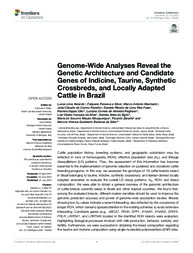Genome-wide analyses reveal the genetic architecture and candidate genes of indicine, taurine, synthetic crossbreds, and locally adapted cattle in Brazil.
Genome-wide analyses reveal the genetic architecture and candidate genes of indicine, taurine, synthetic crossbreds, and locally adapted cattle in Brazil.
Author(s): VERARDO, L. L.; SILVA, F. F. e; MACHADO, M. A.; PANETTO, J. C. do C.; REIS, D. R. de L.; OTTO, P. I.; REGITANO, L. C. de A.; SILVA, L. O. C. da; EGITO, A. A. do; ALBUQUERQUE, M. do S. M.; ZANELLA, R.; SILVA, M. V. G. B.
Summary: Cattle population history, breeding systems, and geographic subdivision may be reflected in runs of homozygosity (ROH), effective population size (Ne), and linkage disequilibrium (LD) patterns. Thus, the assessment of this information has become essential to the implementation of genomic selection on purebred and crossbred cattle breeding programs. In this way, we assessed the genotype of 19 cattle breeds raised in Brazil belonging to taurine, indicine, synthetic crossbreds, and Iberian-derived locally adapted ancestries to evaluate the overall LD decay patterns, Ne, ROH, and breed composition. We were able to obtain a general overview of the genomic architecture of cattle breeds currently raised in Brazil and other tropical countries. We found that, among the evaluated breeds, different marker densities should be used to improve the genomic prediction accuracy and power of genome-wide association studies. Breeds showing low Ne values indicate a recent inbreeding, also reflected by the occurrence of longer ROH, which demand special attention in the matting schemes to avoid extensive inbreeding. Candidate genes (e.g., ABCA7, PENK, SPP1, IFNAR1, IFNAR2, SPEF2, PRLR, LRRTM1, and LRRTM4) located in the identified ROH islands were evaluated, highlighting biological processes involved with milk production, behavior, rusticity, and fertility. Furthermore, we were successful in obtaining the breed composition regarding the taurine and indicine composition using single-nucleotide polymorphism (SNP) data.
Publication year: 2021
Types of publication: Journal article
Unit: Embrapa Dairy Cattle
Observation
Some of Embrapa's publications are published as ePub files. To read them, use or download one of the following free software options to your computer or mobile device. Android: Google Play Books; IOS: iBooks; Windows and Linux: Calibre.
Access other publications
Access the Agricultural Research Database (BDPA) to consult Embrapa's full library collection and records.
Visit Embrapa Bookstore to purchase books and other publications sold by Embrapa.

